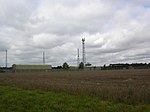Bure Broads and Marshes

Bure Broads and Marshes is a 741.1-hectare (1,831-acre) biological Site of Special Scientific Interest north-east of Norwich in Norfolk. Most of it is a Nature Conservation Review site, Grade I and National Nature Reserve. Two areas are nature reserves managed by the Norfolk Wildlife Trust, Cockshoot Broad and Ranworth Broad. It is part of the Broadland Ramsar site and Special Protection Area and The Broads Special Area of Conservation,This is described by Natural England as a "nationally and internationally important wetland complex", which is situated on fenland peats in the floodplain of the River Bure. A notable feature is an extensive area of swamp alder carr on unstable peats and mud. There are a number of rare bird and butterfly species.
Excerpt from the Wikipedia article Bure Broads and Marshes (License: CC BY-SA 3.0, Authors, Images).Bure Broads and Marshes
Ferry View Road, North Norfolk
Geographical coordinates (GPS) Address Nearby Places Show on map
Geographical coordinates (GPS)
| Latitude | Longitude |
|---|---|
| N 52.69 ° | E 1.473 ° |
Address
Ferry View Road
Ferry View Road
NR12 8PT North Norfolk
England, United Kingdom
Open on Google Maps











